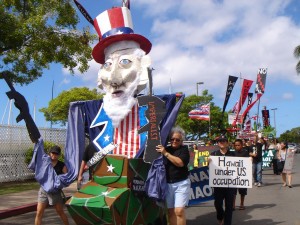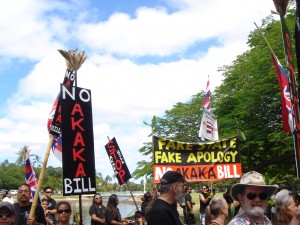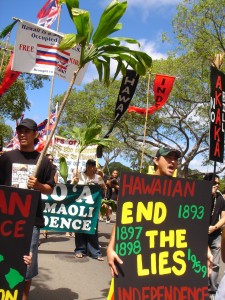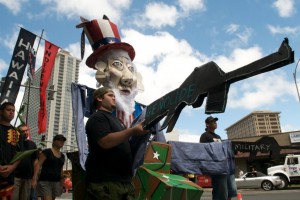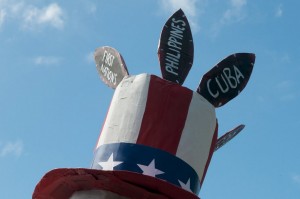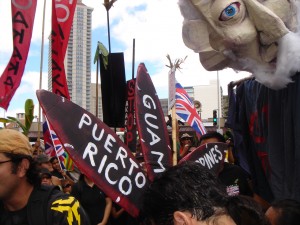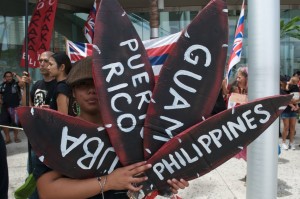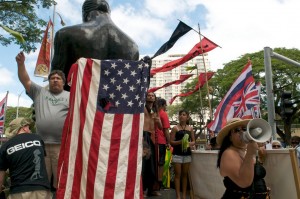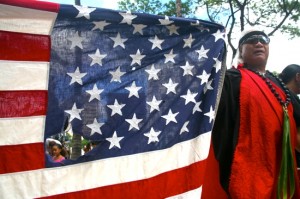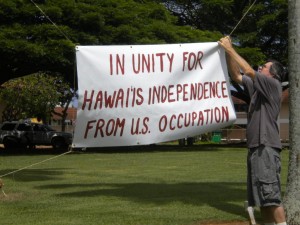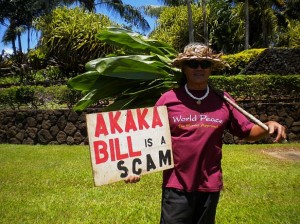NŪHOU / NEWS
 |
Since World War II, soldiers, marines, reservists and members of the National Guard have trained for combat at Mākua. KWO archive photo.
|
Mākua range re-opening cause for legal conflict and military outreach
By Liza Simon / Ka Wai Ola Loa
The U.S. Army is set to resume live-ammunition training in O’ahu’s Mākua Valley under a plan that military officials say scales back operations and decreases the risk of hazardous impacts. The claim is being disputed by community opponents who vow to continue their legal challenge that resulted in a 2001 court ban on combat exercises in the valley pending a complete environmental examination of the 4,190-acre Wai’anae Coast site.
Eight years after the ban was put in place as part of the Army’s legal settlement with community group Mālama Mākua, the Army in June released the court-ordered final environmental impact study. In a subsequent “record of decision” made public on July 24, Army officials said the EIS provides information that shows the military can effectively balance training needs with stewardship at Mākua by following a plan that it says rolls back the scale of an earlier “preferred alternative,” which called for an annual 200 Convoy Live Fire Exercises (LFX) and 50 Combined Arms Live Fire Exercises (CALFEXES).
“Rather, the Army has decided on a greatly reduced option to 32 CALFEXs and 150 convoy-live fire exercises per year without the use of tracer ammunition, anti-aircraft Tube-launched, Optically-tracked, Wire-guided- or TWO missiles, 2.75-caliber rockets, or illumination munitions of any kind,” said Loran Doane of the Army Garrison Media Relations in an email response to Ka Wai Ola Loa. “The elimination of these weapons systems greatly reduces the risk of range fires and environmental threats to endangered species and cultural sites, yet allows small units to train locally without the costly burden of additional deployments to Pōhakuloa (Hawai’i Island) or elsewhere,” Doane added.
 |
At Mākua, a series of brushfires started by munitions explosions has spurred legal action to stop the Army from training in the valley. KWO archive photo
|
Doane also stressed that the Army followed guidelines of the National Environmental Policy Act (NEPA) in involving the local community in finalizing the Mākua Environment Impact Statement, or EIS. He said Native Hawaiians and their organizations participated in eight public meetings and gave oral and written comments, which were incorporated into the EIS. “(This) allowed for a full and fair discussion of significant environmental impacts. By providing means for open communication between the Army and the public, the procedural aspects of NEPA promote better decision-making,” Doane wrote.
But Wai’anae Harbor Master William Ailā Jr., a member of Hui Mālama O Mākua – an organization for cultural stewardship of Mākua Valley (and a supporter of Mālama Mākua, the group that filed the Mākua lawsuit) – said the EIS and decision to restart live-fire operations at the Mākua Military Reservation are flawed. “Based on my observations, the (soldiers) overshoot mortars beyond target areas. (Mistakes) are the nature of training exercises, but these adjacent areas have not been surveyed for either cultural sites or endangered species, so the EIS has no directions for mitigating those occurrences or any associated damage,” said Ailā.
As one of four Army training areas in Hawai’i, the military says Mākua offers unique topographical features and a perfect size that is strategically important for coordinated maneuvers of all military branches in Hawai’i.
Ailā argues that the fact that military has functioned efficiently for the last several years without Mākua is the “best indicator” that the Mākua Military Reservation is not so strategic. Ailā said the military should fulfill a promise it made to withdraw from the valley. The military facility is comprised of ceded lands classified by the state as a conservation district, and was set aside in World War II by the then-territorial government for military training purposes until 2025.
 |
Once a thriving agricultural boon for Native Hawaiians, Mākua Valley is now littered with unexploded munitions. KWO archives photo
|
Terms of the 2001 legal settlement required the Army to cease firing mortars and artillery in Mākua until completing surveys of more than 50 endangered plant and animal species and 100 archeological sites in the valley. A history of accidental wildfires sparked by the combat training was one of the main drivers in keeping the court decision in place. A 2003 brush fire destroyed several thousand acres of valley vegetation. A fire associated with Mākua Army training in 1994 got out of control and jumped Farrington Highway, burning down makeshift beach encampments that were home to several Wai’anae families.
The final EIS evaluated fire and other hazards of military training pertaining to four alternative plans, each one varying in intensity and scope of proposed weaponry uses and number of exercises. Along with an assessment of impacts, each alternative was appraised for the capacity to provide the most realistic training and preparation for the types of threats that soldiers in Hawai’i would expect to encounter in combat situations in Afghanistan and Iraq. Three of the four alternatives describe different training levels based in Mākua; the fourth is situated in Pōhakuloa Training Area on Hawai’i Island. The EIS also analyzes the cost and logistics of mitigating impacts of training that violate state and federal laws protecting endangered species, archeological sites and human health.
But the EIS information does not satisfy Earthjustice attorney David Henkin, who has represented Mālama Mākua in the nine-year-old lawsuit against the Army at Mākua. “The U.S. Fish and Wildlife Service has been allowed access to the training area and has concluded that there will be destruction to the native forest (with the resumption of training), but it is their kuleana to make sure there is no extinction and they have concluded they have proper measures to achieve this, but this is not the same thing as avoiding damage to irreplaceable cultural and environmental treasures, which is too high a price to pay for military training at Mākua,” said Henkin, who also disputes that the Army’s newly announced plan for Mākua marks a decrease in training. “The proposal is to use the same company level of training that existed when litigation started up in 1998.” Henkin said the Army played a “common trick” on the public by first selecting an alternative using weapons systems banned for decades. “Then they ratcheted back from the horrendous to the awful and expected the public to see this as responsive.”
Henkin called the Army’s “record of decision” a violation of the 2001 legal settlement and said he will represent Mālama Mākua in federal district court as early as this month in asking Judge Susan Oki Mollway to set aside the EIS and continue the injunction against live-fire training in the valley on O’ahu’s Leeward Coast. He says that the Army did not give serious consideration to alternative plan four, which would have moved the training maneuvers to the roomier and more remote Pōhakuloa Training Area. Army claims that this would incur cost and impose the hardship of extended separation on military families are exaggerated, Henkin said.
The Army said it would not comment on the proposed litigation. Army spokesperson Doane said that the lead expert in mitigation measures at Mākua could not be reached for comment in time for Ka Wai Ola Loa publication. The final Mākua EIS summarizes regulatory and administrative steps for mitigating risks associated with the live-fire activities; this includes the conservation recommendations of the U.S. Fish and Wildlife Service, which has authority to enforce regulations under the Endangered Species Act. In addition, Army officials have said they have plans to spend $6 million in Mākua on cultural and environmental site management.
The fact is that the Army is dedicating resources to staying at Mākua stems from fear of giving up property in Hawai’i, according to Ailā. “That was their foregone conclusion going into the EIS and that has swayed the results,” said Ailā, who traces his Native Hawaiian roots back several generations in the valley.
 |
A live fire training area since World War II, Mākua is the preferred site for simulated combat maneuvers before deployment to the Middle East. KWO archive photo
|
“It has concerned me that the largest pieces of land were taken from and/or are near the largest population centers of Native Hawaiians,” said Ailā, referring to the demographic makeup of O’ahu’s Leeward Coast. “The ongoing conflict over Mākua is an environmental justice issue,” Ailā added.
Ailā said he agrees with a conclusion shared by the Earthjustice attorney Henkin that the EIS does not contain adequate information on below-ground testing for archeological sites and did not finish a marine resources study to meet the community’s satisfaction. Ailā said the question of whether the military activities are resulting in harm to limu and fish from watershed runoff from Mākua Valley was never determined, because the EIS investigators “gathered the wrong species of limu from near beaches.” In addition, he said the EIS study identified arsenic and an estimated 40 other contaminants in fish from the Wai’anae Coast but did not determine if the elements were from a natural source or associated with the live-fire exercises.
Meanwhile, Nānākuli resident Bill Punini Prescott, a retired sergeant first class, said the legal challenge and opposition to Mākua military presence does not have widespread support from Native Hawaiians, including himself. “My main concern is that our soldiers are adequately trained so that they are not in harm’s way when they are fighting for our country,” said Prescott. “My neighbor just spent one year away from his family in Iraq. Now he is being sent to Fort Hood for training, when he could have gone right down the road to Mākua,” said Prescott.
Prescott said he is also has concerns about the taxpayers money that Congress is giving to rebuild and make accessible Mākua cultural or environment sites. Heiau, stone terraces and water springs are found elsewhere on the Leeward coast, he said. “Practitioners are giving many different opinions on what is sacred. It does not sound like Mākua is the only place that they can observe their traditions,” he said.
Prescott said he believes a majority of Native Hawaiians are more concerned about loved ones who have gone on active duty deployment in the Middle East wars than with the task of making Mākua safe for public use again. “The cost is prohibitive. During World War II, the valley was the central training area for troops landing on (O’ahu’s) beaches. In support of these operations, there were preparatory landings from ships, and bombing by air and land artillery. As a consequence, there are unexploded munitions not only in the valley but on the mountain sides, as evidenced after heavy rains. Additional live firings during the Korean and Vietnam wars also added more unexploded weaponry, thereby adding to the cost for clean-up,” he said.
The 2001 court settlement has allowed for 26 non low intensity training events in five years on the condition that the Army would continue to work on the EIS, but last December’s heavy rains wrecked valley roads that function as legally required firebreaks. No training has taken place since then. This prompts Earthjustice attorney Henkin to suggest that the lack of effective fire suppression coupled with current dry weather conditions raises the risk for brushfires and will prevent the Army from immediately implementing its “record of decision.”
But Army spokesperson Doane said road repairs will move along quickly with a recent infusion of $6 million in federal aid. While acknowledging that firebreak road repairs must be done before live fire training starts up again, Doane said other types of combat-readiness exercises may begin immediately.
The resumption of flying bullets and exploding ordnance at Mākua coincides with a major Army outreach campaign to Native Hawaiians. The Army has briefed the Council on Native Hawaiian Advancement and Alu Like Inc. on the military in local economic development and employment issues, said Doane.
Earlier this year, Army Col. Matthew Margotta hired Annelle Amaral as the Army’s new Native Hawaiian liaison. Amaral, who said she has served as a mediator at oft-times contentious public meetings on the military’s plan for the Stryker Brigade in Hawai’i, said that Margotta epitomizes a new generation of military leaders who value cultural sensitivity. “He has said many times that ‘this is not your father’s Army,'” said Amaral, a former member of the Honolulu Police Department and a former elected official. She added that the new command this year has poured $1 million into ensuring that Mākua valley’s Hawaiian cultural sites are accessible
At the Army’s request, Amaral last month organized a helicopter tour of the Mākua range for Hawaiian leaders. “The idea was to invite those with large constituencies so they can inform others about the work that has been going on in the valley,” said Amaral, adding that the invitees asked many probing questions. “I was proud that they took this tack.”
Those who made the trip included Hawaiian business executive Chris Dawson and Hawaiian Civic Club leader Leimomi Khan.
Mākua Military Reservation critic William Ailā was not invited on the tour and neither were any other members of Hui Mālama O Mākua or Mālama Mākua. “I am disappointed that the people in the trenches working on the restoration of the valley were not there to give some historical context,” said Ailā. “As cultural practitioners, our access to the valley has been limited to about 20 percent of what it used to be,” he added, explaining that a new Pentagon policy prevents people from going anywhere in the valley where ground has been checked to a depth of 12 inches for unexploded ordnance. “They say it is about liability, but I am willing to sign a waiver. There’s an ongoing problem of access and just another reason to look forward to the promised return of Mākua to the community.”
The training site that is bordered by the ridge of the Wai’anae Coast mountains and continuous white sand beaches was once renowned as Hawai’i’s breadbasket, Ailā said, adding that “more than 100 years ago, Mākua had a reputation on the U.S. continent for supplying the sweetest melons, abundant sweet potatoes and mountain apple.”
Kahu Kaleo Patterson, who took the Chinook helicopter ride into the valley last month, said the Army guides had “a lot of good things to say about wanting to reach out the community. “I would say it’s important to take the military up on its offer and reach back. Request the education (about their environmental work) they say they want to offer. Go see for yourself and don’t just jump on one side, based on what you hear second-hand.”
Patterson said that at the end of the tour he found himself standing next to Col. Margotta at on a high ridge overlooking the expansive ocean bay. “I told him that so many of our island families have buried loved ones or scattered their ashes out there. We’ve honored our loved ones by floating leis on the waves out there,” he said. “This is a reminder that this valley is not just filled with cultural resources and endangered species. It is very sacred and activity that takes place here should take this into consideration. If this place is eventually restored as an ahupua’a, it could have importance to all the world.”
“It’s too bad there is no section in that EIS that talks about spiritual impacts,” Patterson said.


